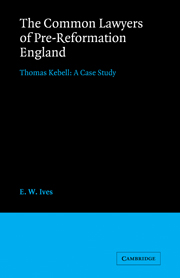Book contents
- Frontmatter
- Contents
- List of figures and tables
- Preface
- Abbreviations
- Manuscript sources
- Table of cases
- Introduction
- PART I THE LEGAL PROFESSION
- PART II LEGAL PRACTICE
- PART III THE LAWYERS AND THE LAW
- PART IV THE PROFESSION AND SOCIETY
- 13 The rewards of the profession: fees and payments
- 14 The rewards of the profession: income and morality
- 15 The rewards of the profession: the estates of Thomas Kebell
- 16 The rewards of the profession: Humberstone Manor
- 17 Social mobility: the Kebells of Humberstone
- 18 Thomas Kebell and the pre-Reformation legal profession
- Retrospect
- Appendices
- Index
15 - The rewards of the profession: the estates of Thomas Kebell
Published online by Cambridge University Press: 05 November 2011
- Frontmatter
- Contents
- List of figures and tables
- Preface
- Abbreviations
- Manuscript sources
- Table of cases
- Introduction
- PART I THE LEGAL PROFESSION
- PART II LEGAL PRACTICE
- PART III THE LAWYERS AND THE LAW
- PART IV THE PROFESSION AND SOCIETY
- 13 The rewards of the profession: fees and payments
- 14 The rewards of the profession: income and morality
- 15 The rewards of the profession: the estates of Thomas Kebell
- 16 The rewards of the profession: Humberstone Manor
- 17 Social mobility: the Kebells of Humberstone
- 18 Thomas Kebell and the pre-Reformation legal profession
- Retrospect
- Appendices
- Index
Summary
In fifteenth-century England, success and security were measured in one commodity–land. Coin, plate and jewels were wealth, but land was the gilt-edged investment, safe, enduring and the clearest blazon of gentility. Supply, however fell far below the demand. Much was in the dead hands of the crown, the church and the corporations, and a good deal more was subject to entail. As for demand, established landowners were always anxious to add to estates where possible, but even more vigorous competitors were younger sons of the gentry and wealthy men of humble origin. The first, deprived by primogeniture of any adequate inheritance, needed land to survive, while the second sought it as the accolade of respectability. For some, marriage with an heiress brought the land they sought–typical of these landed gentry by courtesy of their wives was Walter Kebell the elder; others turned to trade or, as Walter's youngest son Thomas did, to the law for the money to purchase an estate. Many indeed were lucky in both marriage and business but not Thomas Kebell; with one vital exception all his property was purchased with the profits of his profession.
By the end of his life, Serjeant Kebell owned property in some twenty villages in Leicestershire and in Leicester itself. He had also begun to look for investments elsewhere, and after his death the crown made enquiries for property he might have held in Derby, Nottingham, Rutland, Northampton, Warwick and Stafford, as well as the automatic investigation in Leicestershire.
- Type
- Chapter
- Information
- The Common Lawyers of Pre-Reformation EnglandThomas Kebell: A Case Study, pp. 330 - 353Publisher: Cambridge University PressPrint publication year: 1983



